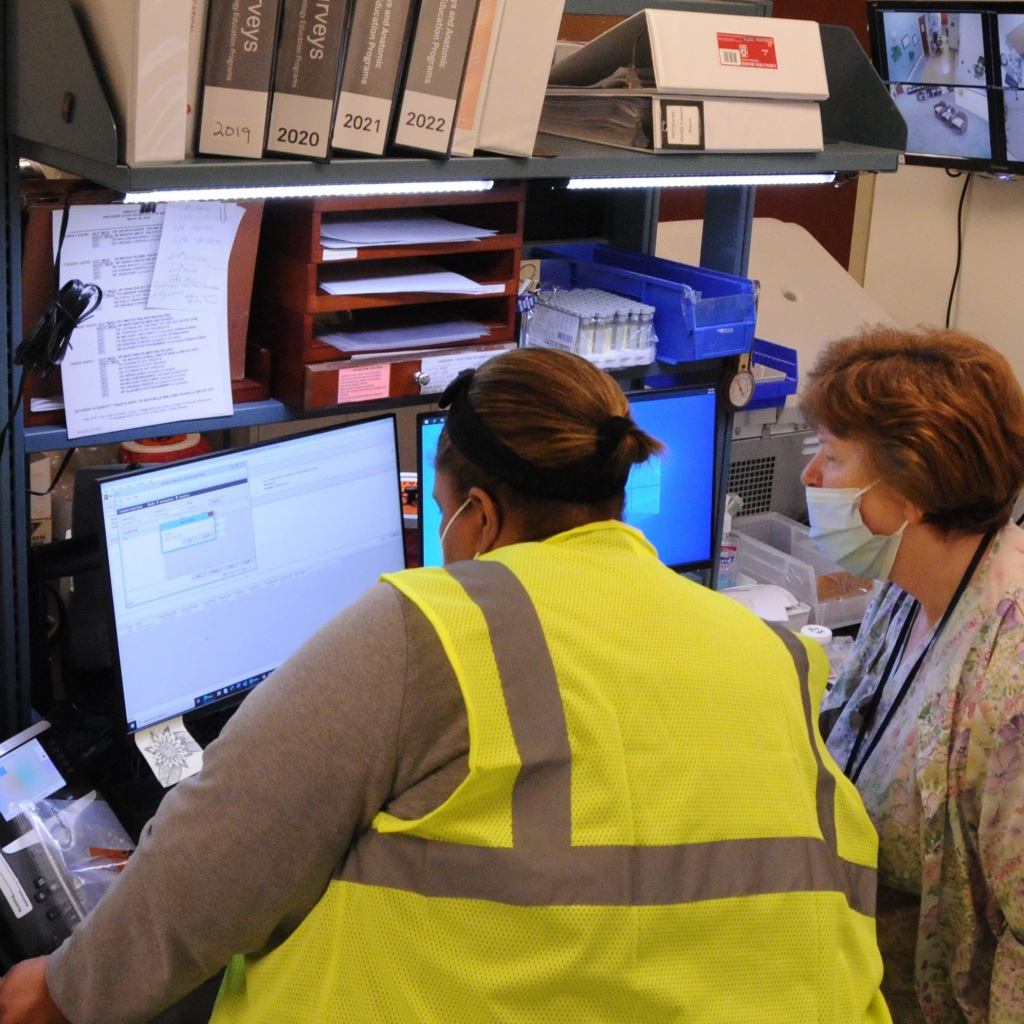Editor’s note: This interview was edited for clarity and brevity.
Holly Joers is the sort of champion you want on your side. The program executive officer for Defense Healthcare Management Systems, she brims with excitement when discussing the future of health care for Veterans and active-duty service members.
“I don’t think we’ve even scratched the surface of what we can do with a single system going forward and the benefits it will bring,” Joers said.
Since joining the Federal health space in 2019, Joers has worked hard to lay the building blocks of the future, serving as the interim deputy director of the Federal Electronic Health Record Modernization (FEHRM) office, where she helped establish the office’s organizational structure and priorities. The FEHRM works within the federal space to implement a single, common Federal electronic health record (EHR) that enhances patient care and provider effectiveness. The FEHRM unites efforts and delivers common capabilities that enable VA, Department of Defense (DoD), Department of Homeland Security’s U.S. Coast Guard and other federal agencies to deploy the Federal EHR.
Now serving as the DoD lead in the effort to implement a comprehensive Federal EHR, Joers sees her tenure at the FEHRM as essential to understanding how VA and DoD can work together to transition to a single EHR.
As of June 2022, Joers and her team have transitioned 74 of 138 military treatment facility (MTF) commands to the new EHR (about 54%) with approximately 114,000 health care providers nationwide. DoD’s deployment effort is at its peak, and the team plans to complete deployment to all its MTFs by the end of calendar year 2023.
Joers explained how her team deployed the new EHR simultaneously at multiple sites and described what she sees as the future of health care.
Q: How has your experience as interim deputy director for the FEHRM helped you transition to your role in DoD?
A: When I was standing up the FEHRM in late 2019 to early 2020, not only did I gain knowledge about the federal EHR landscape, but I also learned so much about the VA mission and how it is complementary to the military health mission.
Over time, I developed a close working relationship with VA leadership and an understanding of how VA’s processes are similar to ours, learning what’s needed to work effectively together. That foundational understanding shaped my mindset that this isn’t just about deploying a system — this is about how we effectively operate the system and its applications to build care for patients.
Q: How do you collaborate with your VA partners?
A: Our team thinks about how we collaborate from the lowest working level up to the leadership level when making day-to-day management decisions. With every decision we [DoD] make, we understand that it is not a sole decision. We constantly think about what the impact is for others using the system and vice versa.
For example, at the executive level, there are recurring touchpoints on a regular basis and ad hoc phone calls. At times, Mr. Bill Tinston, the director of the FEHRM, will call me to say, “Hey, we have a common challenge or opportunity we want to talk about,” and we’ll get on the phone about it. The entire spectrum of operations is taken into consideration.
Q: Tell us about your first EHR deployment.
A: For the first wave [the process of deploying the EHR at multiple sites simultaneously], called Wave TRAVIS, we assembled four MTFs and their supporting clinics. We looked at their workflows and made sure people understood how one role affects the next person down the line. We also improved our training and focused on mitigating known risks, which greatly freed up resources to deal with any unknown risks that arose.
A notable experience from our initial EHR deployment was the contribution from one of the commanders [DoD’s equivalent of a VA medical center director], Col. Kristen Beals. I observed how her great leadership — guiding her team through this complex transformation — made it very apparent that the secret sauce to a successful deployment is the leadership on the ground.
So, we developed a commander’s workshop called the Pay-It-Forward program that starts 15 months before go-live. There, we gather the entire cohort of a deployment wave to talk about expectations, the critical roles that they need to staff and how important it is to have the right people in those critical roles. We also talk about their anxieties and concerns, and most importantly, we bring in peers who just went through the go-live process and can speak frankly about their experience. The peer experts also provide at-the-elbow training and assistance to new users during the critical go-live period which helps new users build confidence faster.
Q: How was DoD able to transition more complex sites to the EHR?
A: It’s not necessarily one-size-fits-all. For example, when we transitioned Brooke Army Medical Center in San Antonio, Texas, to the new EHR at the end of January, we brought on a level 1 trauma center, a major hematology-oncology center, a burn center and a unique aspect called [the] Secretarial Designee Program, which provides trauma care to residents of the city of San Antonio and 22 counties in southwest Texas, creating a new dynamic.
It’s cliché, but it’s one bite at a time. It is about having the right enterprise approach to say, “How do we use these workflows appropriately?”
We talked to other users of the EHR that have complex workflows. For example, we brought in providers from the Jackson Health System in Miami, Florida, to talk about best practices managing complex trauma workflows using the EHR. Those discussions helped us configure new enterprise-wise workflows to standardize the new EHR.
Deploying a new EHR is not about trying to match processes and workflows used today, it is about taking this opportunity to standardize, innovate and optimize how you use the new IT solution to improve outcomes.
Q: What do you see as the future of health care with this modernized EHR for DoD and VA?
A: I get really excited about the future. My mantra is, “forward motion.” Let’s keep moving and get the foundational enterprise workflows and standards set, so we can innovate and optimize. When our service members transfer from one military base to the next, they should experience the same health care delivery processes.
A centralized system brings computable data available in real time. How do we use that data? Joint registries are an area we can grow. While VA and DoD call the joint registries different names, they are in the same system, and we want to harness the power of our interconnectedness.
I can imagine that, at the end of the day, when someone leaves active duty and they arrive for the first time at a VA facility, their benefits are automatically calculated based on their longitudinal record. No more repeating exams and tests; hard copy service records could be a thing of the past.
Working together, DoD and VA are on the precipice of making the transition to Veteran status so much easier in the future for our soldiers, removing burdens during a time that is already extremely stressful.
About Holly Joers

As the program executive officer for the Defense Healthcare Management Systems, Holly Joers oversees and provides guidance to multiple program offices, including the DoD Healthcare Management System Modernization’s delivery of a single federal electronic health record, the Joint Operational Medicine Information Systems’ delivery of operational medicine capabilities and the Enterprise Intelligence and Data Solutions program targeting data innovation. Photo courtesy of the Department of Defense.
EDUCATION: Holly Joers holds a Bachelor of Science degree in marketing management from Virginia Tech, a Master of Business Administration from the University of West Florida and a Master of Science in national security and resource strategy from the National Defense University. Joers began her career in the Air Force, where she served for 16 years in various leadership positions.
AWARDS: She has received numerous awards and honors, including the Air Force Civilian Achievement Award, Air Armament Center Acquisition Logistician of the Year, Air Force Exemplary Civilian Service Award, Air Force Program Manager of the Year and the Office of the Secretary of Defense Exceptional Civilian Service Award.
More Stories
| August 23, 2022
VA has the Veteran’s back when it comes to cybersecurity and data privacy
With few exceptions, most of us are online. That means our personal information, including personal health information (PHI), is online, too. As VA transitions to a new Electronic Health Record (EHR) system ― the software that stores health information and tracks patient care — security of PHI is a critical element.
| June 30, 2022
VA adjusts Electronic Health Record (EHR) rollout schedule to assure continued success
To allow additional time to prepare for implementation, VA recently updated the deployment schedule of its new Electronic Health Record (EHR) system.
| May 30, 2022
New Electronic Health Record (EHR) system saves hours a day for VA lab staff in Walla Walla, Washington
The Department of Veterans Affairs’ new Electronic Health Record (EHR) is saving lab staff hours of work each day at the Jonathan M. Wainwright Memorial VA Medical Center, in Walla Walla, Washington.




